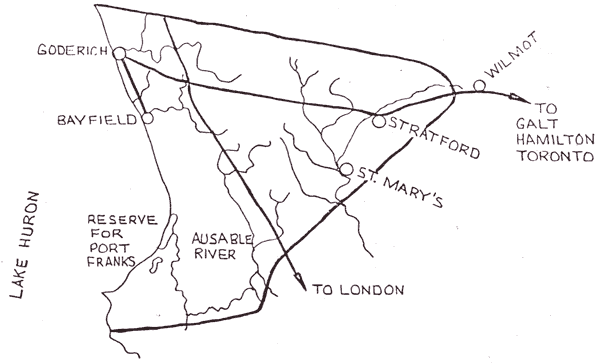Today’s St. Joseph hamlet is a small part of what was known as the Huron Tract.
Land For Sale: 1.1 Million Acres for £145,150

Unsuccessful in its bid to buy more than 2 million acres of surveyed British Crown Reserves and Clergy Reserves in Upper Canada, the Canada Land Company settled for 1.1 million acres of un-surveyed land west of London. On May 24, 1826, the Canada Land Company paid the Crown £145,150 ($295,000) for a territory that would eventually become the counties of Huron, Perth and parts of Lambton and Middlesex.
The Canada Land Company, formed in 1824 by John Galt and other businessmen, was created for the purpose of buying and settling land in Upper Canada. Many of today’s township names, such as Hay, Stephen, Usborne and Bosanquet are named for those Canada Land Company shareholders.
Public Works A Condition of Sale
The agreed upon value of the land – £145,150 – was distributed two ways:
- The Canada Land Company was required to spend one-third of the land’s value (£48,384) on public works and improvements. This meant canals, bridges, roads, churches, wharves, school houses and other infra-structure construction undertaken for the benefit of all residents within the area.
- The remaining two-thirds of the land’s value (£96,766) were paid to the British Crown.
Settlement Begins
By 1846, when the first of St. Joseph’s French Canadian ancestors arrived in the Huron Tract, the Canada Land Company, its agents, surveyors, contractors and employees had accomplished:
- land survey of the entire area by Mahlon Burwell and John MacDonald
- construction of various transportation routes, such as a sleigh track and road from Wilmot to Goderich, a road from London to Goderich and from Bayfield to Goderich
The famous Dr. “Tiger” Dunlop was the contractor for the road from Wilmot, near Stratford, to Goderich. He was one of the most colourful figures of the 1820s and 1830s in Upper Canada and was a veteran of both sides of the Napoleonic Wars. (Historical plaque)
Another interesting personality was Colonel Anthony van Egmond, who established himself near Seaforth. The town of Egmondville perpetuates his name and Van Egmond acquired large amounts of land since the Canada Land Company paid for his work in land.
French Canadian Settlers Arrive
In 1833, the Huron Tract’s population was set at 685 people. By 1846, when the first French Canadian settlers arrived, Huron’s population was about 8,000 people and encompassed the present-day areas of Bruce, Perth and Huron (and Biddulph and McGillivary townships).
Goderich was Huron Tract’s main “urban area” and also the site of the Canada Land Company’s headquarters. In 1846, Goderich was a thriving village of about 1,200 people, with shops, a grist mill, an iron foundry, a wool carding mill, churches and schools. It was first to Goderich that French Canadian families arrived after leaving Quebec. They left an area of more than 200 years of settlement and civilization to trek westward, to virtual wilderness, to become pioneers. The French-Canadian families who migrated to Goderich and onwards to St. Joseph can be credited with the honour of being among the very first settlers to break the land in Huron District.
Other than Goderich, only a few other small settlements existed in the district:
- Clinton consisted of a tavern at the junction of the London and Stratford roads
- Colonel Van Egmond had built an inn at Egmondville and the beginnings of Seaforth
- Present-day Exeter was marked only by a small clearing called Willis and William McConnell’s mill located where the “London Road” (Highway 4) crosses the Ausable River
- A few scattered homesteads could be found along roads
Fact & Folklore
One of the popular stories told in the area is that it was visited by Samuel Champlain in 1615 and by the Jesuits in 1640.
Champlain is supposed to have gone to Georgian Bay by way of Lake Simcoe after his battle with the Iroquois at Oswego. He may have followed the eastern shore of Lake Huron to meet with the Indians of the Detroit area. While on this journey, it is possible he camped somewhere along the shores of the lake in the vicinity of St. Joseph.
At one time, there was a sign in front of the parish church which proudly told of Champlain’s probable visit.
It may also be true that the Jesuits – Brébeuf, Father Jérôme Lalemant and Chaumonot – may have passed through the area on their journeys to and from their settlements in Huronia. There is evidence that the Jesuit Mission of St. Francois was somewhere near Grand Bend.
In 1820, a hunter from the French settlements around Detroit told of having found the ruins of a large European dwelling near the Ausable River. The ruins included a large stone fireplace and chimney and the fact of large trees growing inside the ruins was evidence of the ruins age. Stories persist in the Grand Bend / Port Franks area that these ruins do exist buried beneath shifting dunes.
